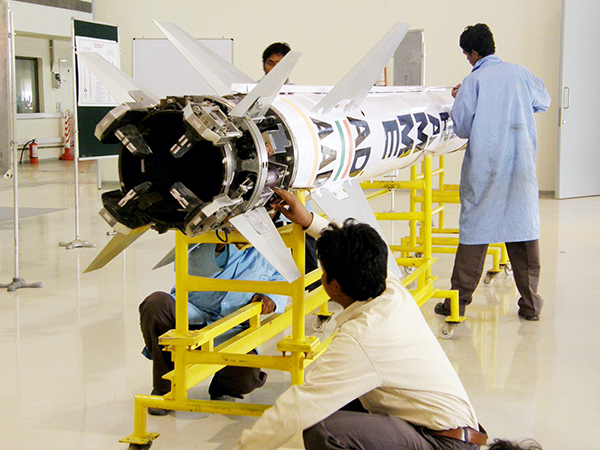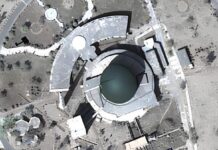Missile Defence Capability Required For Second Strike
The Indian Ballistic Missile Defence (BMD) programme consists of a multi-layered system to protect India from ballistic missile attacks. Phase 1 has been successfully tested and completed and deployment awaits final official permission. Phase 2 is under development.
The system consists of two land and sea-based interceptor missiles, namely the Prithvi Air Defence (PAD) missile for high altitude interception, and the Advanced Air Defence (AAD) Missile for lower altitude interception. The two-tiered shield should be able to intercept any incoming missile launched from 5,000 kilometres away. The system also includes an overlapping network of early warning and tracking radars, as well as command and control posts.
The PAD was tested in November 2006, followed by the AAD in December 2007. With the test of the PAD missile, India became the fourth country to have successfully developed an anti-ballistic missile system, after United States, Russia, and Israel. The system has undergone several tests but system is yet to be officially commissioned.
Out of about a dozen interceptor missile tests, about ten of them were successful, where they destroyed an incoming missile, mimicking the path emanating from an enemy country. These interceptions took place in a direct, hit-to-kill mode, pulverising the enemy missile in mid-flight in exo-atmosphere (above an altitude of 40 km) and in endo-atmosphere (below an altitude of 30 km). In January 2020, the first phase of BMD programme was completed. After the government’s approval to install the missile shield for the national capital it will take three to four years to install shield.
System Configuration
The deployed system would consist of many launch vehicles, radars, Launch Control Centres (LCC) and the Mission Control Centre (MCC). All these are geographically distributed and connected by a secure communication network.
The MCC is the software intensive system of the ballistic missile defence system. It receives information from various sources such as radars and satellites which is then processed by ten computers which run simultaneously. The MCC is connected to all other elements of the defence through a WAN. MCC performs target classification, target assignment and kill assessment. It also acts as a decision support system for the commander. It can also decide the number of interceptors required for the target for an assured kill probability. After performing all these functions, the MCC assigns the target to the LCC of a launch battery. The LCC starts computing the time to launch the interceptor based upon information received from a radar based on the speed, altitude and flight path of the target. LCC prepares the missile for launch in real time and carries out ground guidance computation.
After the interceptor is launched, it is provided target information from the radar through a datalink. When the interceptors close onto the target missile, it activates the radar seeker to search for the target missile and guides itself to intercept the target. Multiple PAD and AAD interceptors can be launched against a target for high kill probability.
Prithvi Air Defense (PAD) Exercise
On 27 November 2006 a PAD missile successfully intercepted a modified Prithvi-II Missile at an altitude of 50 km. The Prithvi-II ballistic missile was modified successfully to mimic the trajectory of M-11 missiles.
On March 6, 2009 DRDO carried out a second successful test of the PAD interceptor missile. The target used was ship launched Dhanush missile which followed the trajectory of a missile with range of a 1,500 km. The target was tracked by Swordfish (LRTR) radar and destroyed by the PAD at 75 km (47 mi) altitude.
On March 6, 2011 DRDO successfully test-fired interceptor missile from AAD, which destroyed a ‘hostile’ target ballistic missile, a modified Prithvi, at an altitude of 16 km over the Bay of Bengal.
Advanced Air Defence (AAD) Missile
Advanced Air Defence (AAD) is an anti-ballistic missile designed to intercept incoming ballistic missiles in the endo-atmosphere at an altitude of 30 km. AAD is single stage, solid fuelled missile. Guidance is similar to that of PAD: it has an inertial navigation system, midcourse updates from ground based radar and active radar homing in the terminal phase. It is 7.5 m tall, weighs around 1.2 tons; and has a diameter of less than 0.5 m.
On 6 December 2007, AAD successfully intercepted a modified Prithvi-II missile acting as an incoming ballistic missile enemy target. The endo-atmospheric interception was carried out at an altitude of 15 km. The AAD with the help of midcourse updates and its terminal seeker manoeuvred itself towards the target. The AAD scored a direct hit at an altitude of 15 km and at a speed of Mach 4.
Due to two successful interceptor missile tests carried out by India, the scientists said that the AAD missile could be modified into a new extended range up to 150 km.
On 15 March 2010, AAD interceptor missile test was aborted, as the target missile deviated from its path and plunged into the sea. But on 26 July 2010, AAD was successfully test-fired. Again, on 6 March 2011, the interceptor AAD missile achieved the desired result with precision. The interceptor missile had its own mobile launcher, secure data link for interception, independent tracking and homing capabilities and sophisticated radars.
On 10 February 2012 and on 23 November 20212, the AAD was again successfully test-fired
Swordfish Long Range Tracking Radar
Swordfish is the target acquisition and fire control radar for the BMD system. The Swordfish Radar, derived from the Israel GreenPine Radar, is a L band Radar. L band Radar is not a imaging radar. It is unable to discriminate decoys.
The Long Range Tracking Radar (LRTR) has a range of 600 to 800 km and can spot objects as small as a cricket ball. The DRDO has upgraded the capacity of Swordfish to 1,500 km. The variant is called Super S Cruise missile defence.
Defence Against Cruise Missiles
Defending against an attack by a cruise missile is similar to tackling low-flying manned aircraft and hence most methods of aircraft defence can be used for a cruise missile defence system. The AAD will be able to handle a cruise missile intercept.
In order to ward off the threats of nuke-tipped cruise missile attack India has a new missile defence programme which will be focused solely on intercepting cruise missiles.
India has also acquired airborne radars like EL/W-2090 AWACS to ensure detection of cruise missiles in order to stay on top of the threat.
The naval version of the Barak-8 long-range anti-air and anti-missile naval defence system developed jointly by Israel Aerospace Industries (IAI) and DRDO has the capability to intercept incoming enemy cruise missiles and combat jets targeting its warships at sea.
The Indian Air Force and Indian Army have inducted a variant of Barak 8 missile to meet its requirement for a medium-range surface-to-air air defence missile. The Akash missile defence system also has the capability to “neutralise aerial targets like fighter jets, cruise missiles and air-to-surface missiles”.
XRSAM (eXtra-long Range Surface to Air Missile) is a long-range mobile surface to air missile defence system under development by DRDO. The missile system will have a range of 250 km against fighter jets, 350 km against cruise missiles, sea skimming anti-ship missiles, AWACS and mid-air refuelers and will be capable of bringing down ballistic missiles and stealth fighters in the terminal stage. The naval version of the missile will also developed to supplement the LR-SAM missile in the Indian Navy.
Chinese Missile Defence
China’s has an advanced anti-satellite programme since 1964. Since its inception, the ASAT program has made progress on the development of three ASAT capable Systems: direct fire, directed-energy weapon, and microsatellites. Tests of these systems have either been directly acknowledged by China, or reported on as ASAT capable. China is pursuing a broad and robust array of counterspace capabilities, which includes direct-ascent anti-satellite missiles, co-orbital anti-satellite systems, computer network operations, ground-based satellite jammers, and directed energy weapons.
The US Defense Intelligence Agency has claimed that China has space weapons capable of shooting out satellites during the early stage of a conflict, including anti-satellite missiles, manoeuvring satellites and lasers and electronic jammers.
People’s Liberation Army has formed military units and begun initial operational training with counterspace capabilities that it has been developing, such as ground-launched ASAT missiles.
Anti-Missile Test
Under a test christened “Mission Shakti”, DRDO’s audacious anti-satellite missile test on 27 March 2019, caught the world’s attention. A three-stage missile launched from the APJ Abdul Kalam Island raced towards a satellite called Microsat-R, which was in low-earth orbit a and destroyed it in a direct “hit-to-kill” mode. Microsat-R was orbiting at a velocity of ten km a second at an altitude of 274 km above the earth when the missile intercepted it and blew it to pieces.
The DRDO had developed this satellite which had defence ramifications and ISRO put it into orbit with its Polar Satellite Launch Vehicle (PSLV) in January 2019.
An official press release said the anti-satellite test demonstrated India’s “capability to defend its assets in outer space”.
In a televised address to the nation soon after the test was executed, Prime Minister Narendra Modi said, “Mission Shakti was a highly complex one, conducted at extremely high speed, with remarkable precision. It shows the remarkable dexterity of India’s outstanding scientists and the success of our space programme.” Modi said Mission Shakti was especial for two reasons: India was the fourth country (after the US, Russia, and China) to acquire such a specialised capability and the entire effort was indigenous.
On 28 April 2019, Dr. G. Satheesh Reddy, Chairman, DRDO said during an event of the Aerospace Society of India (AeSI), at Hyderabad, “The ASAT test demonstrated India’s technological capabilities to carry out such a critical mission with a very high degree of precision.” He said that the critical systems including software and sensors for the ASAT test were developed indigenously, and a team of scientists from various specialisations had worked with synergy day and night for six months. The most important challenge during the mission was to ensure that all the systems responded cohesively to ever-changing dynamics, Dr Satheesh Reddy added.
Dr U. Rajababu, Programme Director, AD (Air Defence), said at the meet “the high altitude and high-velocity interception” posed many technical challenges with respect to the development of seekers for early detection of target and trajectory corrections before the target was engaged. When the relative velocity of the systems involved was around 10 km a second, there was a pertinent need for high levels of precision, he said. “The booster [stage in the rocket] needs to provide the requisite velocities, the technologies such as dome-opening, heat-shield etc… need to be precise and smooth, apart from the highly accurate and secured data communications systems. Using accurate sensors and an onboard seeker, the ASAT missile was guided towards the target to ensure direct hit without employing any warhead,” the AesI press release said, quoting Rajababu.
In an informed paper titled “India’s ASAT Test”, published on March 28, 2019, in International Strategic and Security Studies Programme, National Institute of Advanced Studies (NIAS), Bengaluru, Rajaram Nagappa, Mrunalini Deshpande, and S. Chandrashekar said: “DRDO has developed, as part of ballistic missile defence, missile interception capabilities. In this process, they would have developed kill vehicles with homing and manoeuvring capabilities. Extending the concept for achieving satellite kill is well within DRDO capabilities. Also, DRDO has ballistic missiles which have the capability of reaching 300 km-altitude for carrying out an interception. In fact, it can be inferred from the press release that the missile was a two-stage solid propellant missile and the third stage was the kinetic kill weapon. Press reports talk of a three-minute time to hit the satellite. In three minutes, the satellite would have travelled 1350 km. The interception of Microsat-R, representing perhaps an area of two square metres, the related computations and the real-time manoeuvres needed of the war-head indicate the precision achieved in the missile guidance.”
Comments
While India’s demonstration of its ASAT capability is a major milestone in its space history, it is important for India to complement this capability with a robust Space Situational Awareness (SSA) infrastructure, C4ISR capability and related elements. (C4ISR stands for command, control, communication, computer, intelligence, surveillance and reconnaissance). Major investments in military space and revamping of the military national security set-up as China, Russia and the US have done should receive some serious attention.
Agni-5 is a 3rd-generation ICBM, It is a solid fuel, road mobile missile. It provides reliable “second strike” capability. Agni V has been developed to offset China’s conventional weapons superiority. Agni with MIRVs can raise concerns in the enemy’s mind that India may have adopted “first-use” policy in its nuclear doctrine.
But while Agni surely enhances India”s credible minimum deterrence posture, it cannot strengthen the posture alone. India also needs to equally focus on aerial and sea-based nuclear delivery platforms – together the three legs would enable India to effectively launch counter and second strike vis-à-vis adversaries.
In addition, missile systems especially land-based systems would also need to be protected from enemy attacks. That is where India’s ballistic missile defence (BMD) system to intercept incoming enemy missile systems assumes importance. At present the BMD system is mostly to protect counter-value targets. India should concentrate on protecting counter-force targets including land-based missile systems.
BMD can also be used both as an offensive and defensive system. Agni can be used to launch a “first-strike” on the enemy’s nuclear forces and use its BMD system to prevent adversaries’ missile systems to launch a counter-attack on India’s nuclear and conventional capabilities. However, India needs to clearly elaborate its BMD posture in order to avoid any confusion and state that the BMD would be deployed to strengthen India’s “no-first-use” doctrine.


















